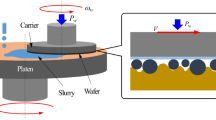Abstract
Gravure is a high throughput printing process, normally associated with speed, quality, and long print runs. It is widely used for printing on shrink films and other substrates. The shrink films, in particular, polyvinyl chloride (PVC) and glycol-modified polyethylene terephthalate (PET-G), are two dominant substrates widely consumed and printed by gravure process. The PVC and PET-G offer different properties which greatly influence the printability. The surface energy of the substrate determines the adhesion and wettability of ink, while electrical properties such as surface and volume resistivity impact electrostatic assist (ESA) performance. The introduction of ESA in gravure further improved the print quality by eliminating dot skips with reduced impression pressure. However, print defects such as print mottle is inevitable. Print mottle occurs due to a discrepancy between substrate, ink, and process parameters which degrade the print quality. These complexities need to be addressed to deliver higher productivity with less print waste. Therefore, the study investigates the effect of process parameters, i.e., substrate type, line screen, air gap (distance between charge bar and impression roller), viscosity, voltage, and speed, and aims to quantify their effect numerically on defect minimization. The Design of Experiments (DOE) was generated for the above-mentioned parameters and analyzed to extract the best combination of process parameters. The optimized setting showed a reduction in solid mottle by 54% and 57% for PET-G and PVC, respectively.





Similar content being viewed by others
References
Mullen, J, “Films For Shrink Sleeve Labels.” Label Expo Americas Conferences. Chicago, 2004
Sharon, K, “The Growing Shrink Label.” Package Print., 50 (9) 55 (2003)
Fahlkrantz, CM, “On Evaluation of Print mottle. Doctoral thesis,” Doctoral dissertation, KTH School of Computer Science and Communication, 2005
Laurent, GG, “Measurement and Prediction Procedures for Printability in Flexography,” Doctoral dissertation, Doctoral dissertation, Royal Institute of Technology, Stockholm, Sweden, 2002
Teleman, A, Christiansson, H, Johansson, PÅ, Fahlcrantz, CM, Lindberg, S, “Correct Measurements of Half-Tone Print Mottle on Flexo Printed Linerboard,” STFI_Packforsk Report No. 39, 2005
Rentzhog, M, Fogden, A, “Print Quality and Resistance for Water-Based Flexography on Polymer-Coated Boards: Dependence on Ink Formulation and Substrate Pretreatment.” Prog. Org. Coat., 57 (3) 183–194 (2006)
Elsayad, S, Morsy, F, El-Sherbiny, S, Abdou, E, “Some Factors Affecting Ink Transfer in Gravure Printing.” J. Pigm. Resin Technol., 31 (4) 234–240 (2002)
Velho, J, Santos, NF, “Surface Topography of Coated Papers: From the Evaluation Process to the Quality Improvement.” Mater. Sci. Forum, 636 977–984 (2010)
Repeta, V, “Influence of Surface Energy of Polymer Films on Spreading and Adhesion of UV-Flexo Inks.” Acta Graphica, 24 (3/4) 79 (2013)
George, HF, Oppenheimer, RH, “Method and Apparatus for Transferring Ink in Gravure Printing,” US Patent 4,697,514, 1987
Rong, X, Pekarovic, J, Pekarovicova, A, “Gravure Printability From Laser and Electromechanically Engraved Cylinder.” International Printing and Graphic Arts Conference, 2004
Haney, MA, “The effect of electrostatic assist on gravure printability.” Gravure Exchange Magazine. Retrieved December 11, 2014 from http://www.gravurexchange.com/gravurezine/0804-ezine/haney.htm
Webster, JR, “Thin Film Polymer Dielectrics for High-Voltage Applications Under Severe Environments,” Doctoral dissertation, Virginia Polytechnic Institute and State University, (1998)
Akram, M, Javed, A, Rizvi, ZT, “Dielectric Properties of Industrial Polymer Composite Materials.” Turk. J. Phys., 29 355–362 (2005)
Steven, JS., “Rediscover the Color with ESA and Water Based Ink.” Retrieved November 23, 2014 from: http://www.hurletron.com/subhtml/pdf/y2k.pdf
Bohan, M.F.J. et al., “Effect of Process Parameters on Product Quality of Rotogravure Printing.” Proc. Inst. Mech. Eng., Part B 214 (3) 205–219 (2000)
Deshmukh, R, Bhat, N, “The Mechanism of Adhesion and Printability of Plasma Processed PET Films.” J. Mater. Res Innov., 7 283–290 (2003)
Deng, PJ, et al., “Influence of Screen Ruling and Engraving Needle Tip Angle on Ink Transfer for Gravure.” J. Adv Mater Res Print Packag Study, 174 215–218 (2011)
Rajala, P, Milosavljevic, N, Kiiskinen, H, Hendrickson, M, “The Effect of the Impingement Air Drying on Print Mottle and Other Coated Paper Properties.” Appl. Therm. Eng., 24 (17) 2527–2536 (2004)
ASTM D257-14. Standard Test Methods for DC Resistance or Conductance of Insulating Materials, 2014
Rosenberger, RR, Stochastic Frequency Distribution Analysis as Applied to Mottle Measurement. Verity IA LLC, Verity Multifunction, 2003
Rosenberger, R, Clark, D, Drake, D, “Back-Trap and Half-Tone Mottle Measurement with Stochastic Frequency Distribution Analysis.” TAPPI 2001 Coating and Graphic Arts Conference and Trade Fair, 2001
Acknowledgment
The authors would like to thank OMNOVA Solutions Inc. for funding the research project and P.V.G’s College of Engineering and Technology, Pune for providing the laboratory support for the work. We would like to express our gratitude to Rossini for furnishing ESA impression rollers for the project. The authors are grateful to Manish Packaging, Garware Polyester Ltd, Acuprint Systems Pvt. Ltd., and Flint Group India Pvt. Ltd. for sponsoring PET-G and PVC substrates, cylinder, and ink for the research.
Author information
Authors and Affiliations
Corresponding author
Rights and permissions
About this article
Cite this article
Joshi, A.V., Dettke, C. & Steingraeber, J. Investigation on electrostatic assist and gravure process parameters on solid mottle reduction for shrink films. J Coat Technol Res 13, 375–383 (2016). https://doi.org/10.1007/s11998-015-9753-5
Published:
Issue Date:
DOI: https://doi.org/10.1007/s11998-015-9753-5




